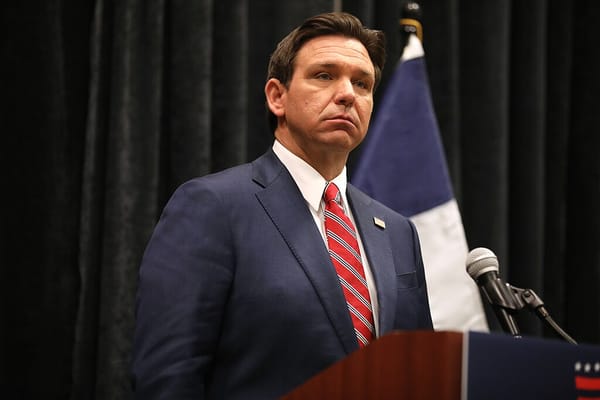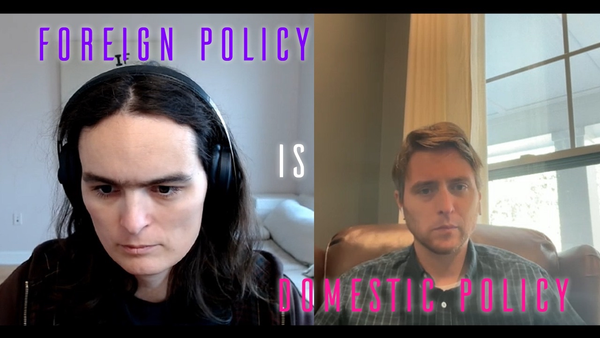No Kings Shows Our Power (When We Have Messaging Reach)
Basic, liberal, anti-fascist messaging is energizing and persuasive when media actually amplifies it.

On Saturday Americans from every walk of life took to the streets in possibly the largest single day of protest in our history.
Numbers are still coming in, but the scale of popular outrage is without precedent. Under the banner of ‘No Kings’ thousands of rallies were held in big cities and small towns, red states and blue. In LA, the eye of the storm for the administration's attempted authoritarian takeover, 200,000 marched. They were joined by 50,000 in San Francisco, 60,000 in San Diego, 2,000 in Mobile, 8,000 in Little Rock, a colossal 1-1.5 million for a joint Pride/anti-Trump event in Boston, 80,000 in Philadelphia, 4,000 in Louisville, and at least 50,000 reported in New York (with the actual number likely being several times that). Initial estimates placed total participation at over 5 million.
It’s not a coincidence that this happened now. Saturday was the culmination of, and built upon, a rare stretch of substantive victories and messaging cut through: Kilmar Abrego Garcia—whose illegal deportation became a symbol of Trump’s authoritarianism—was returned to the US, despite the administration’s insistence he never would be. Contra handwringing that Democrats should stay away from immigration, the focus on the issue has led to a sharp drop in the public’s approval of Trump’s handling of it. Horrific as it is, the federal invasion of California is very unpopular and is increasingly looking like overreach that only energized his opponents.
Some of this could perhaps be described as unforced errors from the administration—a smarter authoritarian might have proceeded more subtly—but given the personalities involved and the nature of fascism itself, I think we can reasonably expect the antagonistic approach to continue. They’ve always been like this. The question is how robustly we oppose it.
What I think we should take away from the last month or two is that basic, mainline liberal, anti-fascist messaging is energizing and persuasive when it is amplified. The resistance did not find some new, special, focus grouped way to talk—the messaging for No Kings was more or less what we’ve been saying for a decade now. The difference was we said it louder.
People like the idea of being ‘tough on immigration’ in theory, but when you can confront them with the reality of what that entails, many quickly lose their stomach for it. Only 7% of the public support cuts to medicare, but liberal framing of Republicans’ current attempt to do just that is not reaching the public. While the MAGA base loves Trump’s authoritarian flourishes, the median voter does not. They just usually encounter them through media that downplays, sanitizes and frames them as a reaction. Our message that it really is as bad as it sounds has been drowned out by those who insist it’s not. The result is a negative feedback loop—it's hard to convince less political people to be alarmed because no one else seems to be.
A divided coalition
This is one of the most fundamental reasons the anti-Trump coalition has struggled: Those most against fascism—both the better elected Democrats and the tens of millions of Americans who see MAGA for what it is—have not had as much access to message amplification. Through the Trump era, the right has continued to strengthen its formidable messaging infrastructure in both traditional and new media. The rest of us became divided on how we see Trump and who we blame for him.
The big reason anti-fascist messaging has so little reach is that most of our media power has consolidated in the hands of people who blame liberalism for fascism.
One simple way to think about this that I’ve found instructive is to divide the 30 or so million Americans who are strongly politicised and against Trump by two axis: How centrist vs progressive they are and how much agency they ascribe the right (do they view MAGA as actively appealing to racism, sexism or conspiracy theory, or do they view it as a reaction, a backlash to liberal social justice excesses, or economic inequality). See here for how this looks in a classical political compass form (note that this is only for the anti-Trump side of the aisle, it doesn’t apply to the right at all).
This gives us four ‘quadrants’, all internally diverse, but with their own distinctive characteristics. They are very different in terms of their size and the communications structures they have access to. Indeed, the number of people in each quadrant is inversely proportional to the messaging power they have.
Traditional media
Liberals prior to Trump became complacent. We somehow, preposterously, took the media ‘both sides’ shtick at its word. Yes, there were some false equivalences, but we’d always be guaranteed our spot. We weren’t. Progressives who focus their blame rightward are a dying breed.
The New York Times and Washington Posts of the world are mostly in the hands of a faction I call ‘reactionary centrists.’ These are people who, though they will usually vote Democratic, do little else but whine about them. In the social justice heyday of the early 2010s they became very concerned with discourse norms—civility, the supposed ‘chilling effect’ of campus protests, and so on. Naturally in the Trump era they have been very drawn to low agency ‘reaction’ accounts of MAGA; writing endless versions of the same column blaming fascism on Democrats' supposed ‘faculty-lounge progressivism’. Famously in 2016, traditional media devoted as much time to Clinton’s email scandal as all policy coverage, or all of Trump’s scandals combined.
And they’ve gotten much worse. Consider someone like Paul Krugman, generally progressive although hardly a communist. Also, broadly speaking, a partisan of the Democratic Party, he pointed out false equivalence, and clocked early on how Republicans increasingly just lie about their platform. By my compass, Paul is in the center of the mainline liberal quadrant. In broad strokes, where most Democratic primary voters are, and many (though not all) elected politicians. Apparently, even this fairly ‘normie’ liberalism was too much for today’s New York Times, and he left to be better able to speak his mind.
Reactionary centrists are not a lot of people. This specific constellation of self-importance, hangups, grievances, and victim blaming represents no electoral constituency on the planet. This quadrant is by far the smallest numerically but has by far the loudest voice. I sometimes feel like there are only a few thousand reactionary centrists in the country and every single one of whom has a prestigious role in legacy media. They set the agenda.
New media
The Democratic Party’s primary vote (and the core of anti-Trump liberals) are not very online. The dominant view here is people who are progressive, but with a low-agency view of Trump—the Bernie movement, socialists, and so on. Those who see Trump as the result of a bi-partisan failure to meet the needs of the working class.
They are larger than reactionary centrists numerically, but still a fairly small slice of the population; the 6% of Americans who thought Harris was not progressive enough provides a maximum, the actual number though is probably closer to 2% who fit this profile. Maybe 6-8 million people in a population of 340 (or the core of Bernie’s Primary vote).
I call this group the ‘anti-establishment left’ (my labels don’t match perfectly with self-definition, but they give a sense). Despite their comparatively small size they are the majority voice on left-of-center social media (or perhaps even social media period). And most political new media (YouTube, podcasts, etc) on the anti-Trump side is done by people in this quadrant—The Young Turks, Hasan Pinker, Jaccobin, Briahna Joy Gray, Left Reckoning and so on. They generally don’t like—often hate—the Democratic Party, so the stories that get shared and reported on by them are those that show them being weak or feckless (of which there are many). This section of the left is also quite insular; they don’t really consume media from outside their quadrant, so their entire perception of liberalism and the Democratic Party is from negative posts/ stories from other people in the anti-establishment left.
This leads to one of the stranger recurring motifs of the Trump era: endless, roiling rage at Democrats for not saying things they in fact say all the time.
Anyone who spends any amount of time on social media should be familiar with this type of post: “Trump is a fascist, why won’t the Democrats say that!?” Or “this is a crisis, Democrats need to say that!” Or “Is anyone in the Democratic party speaking up about this (Musk, unlawful detention, Medicare cuts, etc)!?” In response to the latest outrage de jour, it will be vaguely demanded “Democrats need to be shouting about this!”. More abstractly, the assumed necessity of the posts themselves will be bemoaned “I hate that we have to beg Democrats to speak strongly!”
And yet, leading Democratic politicians have described Trump as a fascist. The conventional wisdom among elected Democrats is that we are in a constitutional crisis. They have issued endless forceful statements attacking Musk, or ‘deportations’, or cuts. The answer to why Democrats aren’t shouting about the latest outrage is often that they already are.
The problem isn’t the messaging. Democratic party messaging can improve in all sorts of ways, but that’s not what’s driving this. It’s that the party’s messaging infrastructure is divided against itself with the different factions not even talking to each other.
A note of hope
This division also makes the majority of the Democratic primary electorate increasingly invisible. The core of the party base, the largest of the quadrants are (what I call) mainline liberals—these are the much derided ‘wine moms’ or the largely ignored older Black voters who gave Biden his victory in 2020. They are progressive but blame fascism on fascists. Earnest, majority female, largely offline, and increasingly absent in traditional media.
Because we (I include myself in this quadrant) are less visible, we (the more online subset of this group) will often get mistaken for (the much more visible) reactionary centrists by the left on social media. Reactionary centrists in turn, tend to dismiss us as simple, unthinking partisans who are far too rude about their opponents (a civility concern never directed rightwards).
The result is that not only do our politicians punch significantly below their weight, but our core constituencies are largely absent from the national conversation. Conservatives of course hate mainline liberals, but even on our side we’re spoken for by people who, at very best, find us annoying.
What seems to have shifted in the last couple of months is our broken messaging infrastructure began—partially and perhaps only temporarily—working again. The dramatic nature of events forced reactionary centrists in the press to cover them. Democrats have always had strong anti-Trump messaging, but seem to be getting better and forcing attention onto themselves. Politicians who take some level of risk, or are personally affected, get greater cut-though—traveling to El Salvador, speaking for over a day on the senate floor, being cuffed at a press conference, or indicted, for instance. Even those who flirted with appeasement like Gavin Newsom seem to have got the message: nothing less than implacable opposition is acceptable.
Online—and this is optimistic and anecdotal—there may also be something of a vibe shift. Belatedly, and with various degrees of condensation, it’s being recognised that the anti-establishment left alone does not have the numbers. I have made the point repeatedly that the left does not need to compromise on policy, but does need to stop blaming liberals (and being so angry with us). That they do not have to uncritically agree with the Democratic Party on everything, but they should focus fire on the fascists. Increasingly it seems like there is some recognition that these narratives have not served them well. Kyle Kulinski for instance, a leading commentator on the left, has admitted how much resistance libs got it right, and even talked up our revolutionary potential.
All of this is very fragile. There is still a loud—and honestly deranged—subsection of the online left who loathe liberals and will not be talked out of it. I doubt it's that many people (and their rage may simply be a reaction to their influence fading), but it shows a dead end that this faction may yet go back to. While a good amount of this faction's clout comes from random (but active) accounts on Bluesky or Twitter, it isn’t just them - Jacobin seems content to run the same “Democrats abandoned the working class” articles until judgement day.
Reactionary centrists in the press are even more dubious. They have not learnt anything. Pressure will have to continue to be applied. Even in giving more coverage to authoritarian actions, they couldn’t help themselves in drawing false equivalences: “The Divide between Peace and Violence is in the Eye of the Beholder” the New York Times preposterously titled its main article on the topic. It seems to have been written by a visitor from another world reading high-level summaries of the main faction's positions without any context, history, or way to verify facts:
The question of which side is justified, and which is not, seems to have divided the country as much as the immigration issue and Los Angeles has been transformed into a stage for a debate over the nature and meaning of American Protest . . . Did the Trump Administration, which deployed National Guard troops, and the Los Angeles Police Department overreact and pour gasoline on the fire? Or were their aggressive actions necessary to prevent the situation spiraling out of control, in a city still haunted by the bloody fiery riot of 1992?
The article at no point answers any of these questions. And to be clear, this is unusually good coverage by the Times’ standards. The anti-establishment left might yet be able to reform, but the mainstream press will have to be replaced.
A louder liberalism
As a mainline liberal, it would be easy for me to lay all the blame on the other quadrants. Certainly, I have my critiques—I think low agency accounts are both wrong, and a poor way of engaging with other parts of the anti-Trump coalition. But on the issue of liberal invisibility, I think we must take responsibility. We have been far, far, too passive in allowing our voice to be drowned out.
The right pays its propagandists, we do not. Any upcoming commentator or platform on the right will get funneled investment from both above and below—wealthy conservative groups love to pump money into this sort of content and their audience has been trained to buy worthless junk (gold coins, survival gear, bogus health supplements) for decades now. I think people who join the fascists for money are despicable, but we also need to be realistic here; incentives matter. Even if people don’t ‘sell out’ they may simply not be able to devote the time to creating political content for free.
Finally, investment builds infrastructure; the right’s new media megaphone did not arise spontaneously, it was created. The Democratic Party has money. There are plenty of affluent liberals in the country—doctors, lawyers, and so on—and they are the ones who pay for news (nobody other than educated middle-income-or-better liberals has a New York Times subscription). We just haven’t been willing to invest in the way the right has, instead rewarding people apologizing for facism with our subscriptions.
So what do we need to do? I don’t have all the answers, but here are some things I would like to see ordinary mainline liberals do to ensure Saturday was not a one off, to ensure we stay in the fight:
- Push for representation within traditional media, even as we recognise its flaws.
- ‘Work the refs’—Complain, mock, call out the press’ double standards. They’re not going to suddenly become reasonable, but we might mitigate the harm somewhat.
- The anti-establishment left built a new media ecosystem. We need to do the same (and these needn’t be in competition).
- Give money to the media you want to see more of. Cancel subscriptions to outlets that aren’t meeting the moment.
- The old constitutional order is gone and it’s not coming back. Mainline liberalism needs a progressive vision for what comes next.
- While the Democratic Party isn’t the cause of Trump, we should be open to switching out leaders who aren’t meeting the moment. Specifically, we should be looking for people who are serious about increasing messaging reach.
- Stay active. Make protesting, attending events and meetups - even small ones - a regular thing. Not a one off.
Obviously, there’s much more to say about all of these, but that, broadly, is the direction I think we need to go in. Saturday’s mobilization shows just how effective we can be when our messaging works together and speaks loudly. Internationally, Australia, Canada and Korea have shown that an aggressive liberalism that clearly defines what we’re against can beat the odds.
Mainline liberalism has been pushed out of the conversation, and we need to push our way back in. Both to rebalance the anti-Trump coalition, and because those not in the fight need to hear a message that blames fascists for fascism. Cautious steps forward will not cut it. In the words of an older liberalism, our circumstances demand bold persistent experimentation
Featured image is "No Kings" Protest in Downtown Los Angeles, by Larissa Puro




